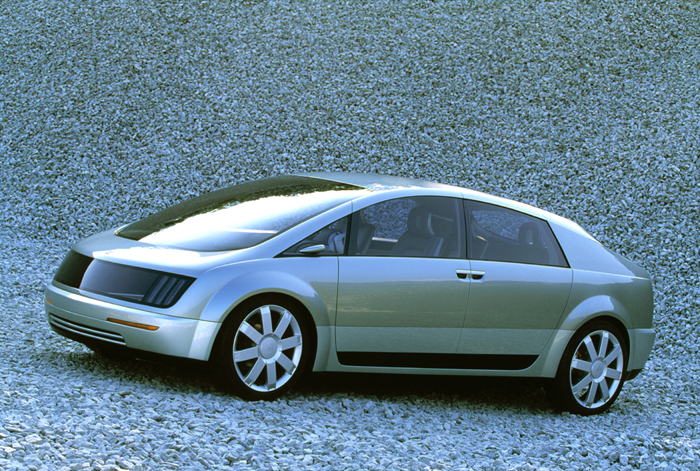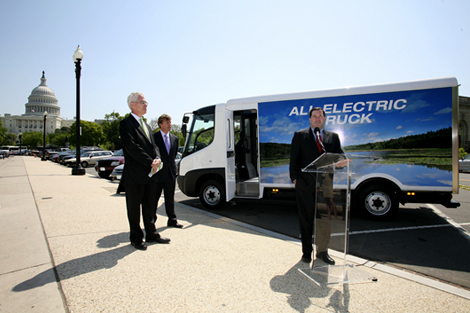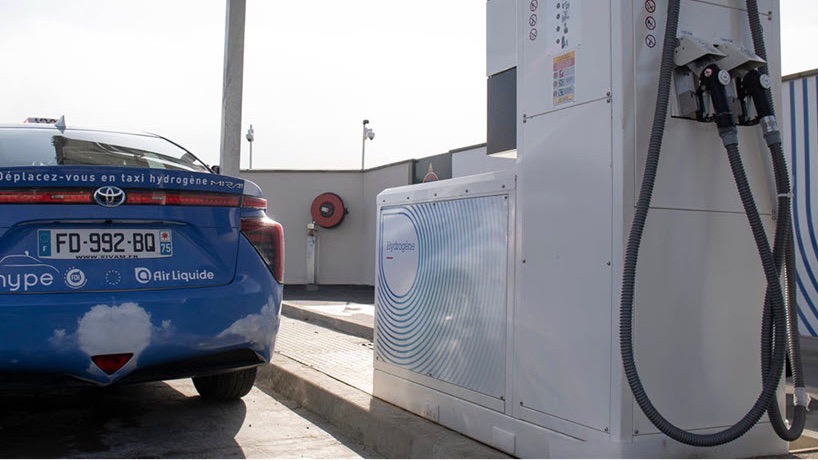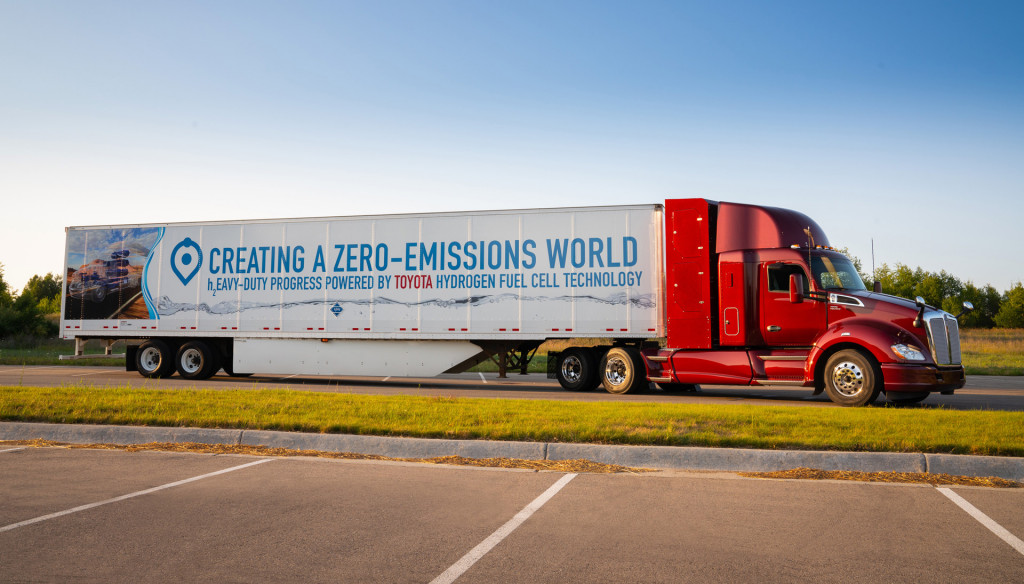The commercial truck maker Navistar International is teaming with General Motors to put 2,000 fuel-cell semis, each with a range of more than 500 miles and 15-minute refueling, into use “in the near term,” the companies jointly announced Wednesday.
For the project, which fits in alongside GM’s $27 billion electric vehicle plan, GM will supply energy to power an electric motor system via two of its fuel-cell stacks—in this case called “Hydrotec fuel-cell power cubes” and each containing more than 300 cells. North Carolina–based OneH2 will supply what it described as a modular hydrogen solution that can be refueled via deliveries for smaller needs or by reforming the hydrogen “on demand” to refuel the trucks.
GM said that this agreement is independent of any other arrangements—namely, that with Nikola Corporation—and doesn’t affect them. As of late November, GM reached a memorandum of understanding with Nikola to supply its Hydrotec system for Nikola’s Class 7 and Class 8 commercial trucks.
The Hydrotec system for the Nikola trucks is due to be manufactured at its Brownstown battery plant, but GM wouldn’t disclose a production location for the units to be used in the Navistar project. The size and scope of the project are much larger than Toyota’s Project Portal, which has employed heavy-duty fuel-cell trucks primarily for port duty so far.
Toyota Project Portal 2.0 fuel cell-powered semi-trailer truck
Navistar plans to deliver the first production versions of the trucks, to be badged the International RH Series fuel-cell electric vehicle, for model year 2024, while test vehicles will start a pilot phase by the end of 2022.
Flexibility, low operating costs, and zero tailpipe emissions
The transport and logistics company J.B. Hunt will be the initial partner for the project. The company has a lot of flexibility for deploying the fuel-cell trucks, with 521 unique locations that the hydrogen hardware might be fitted to, with anywhere from 5 to 200 trucks based at each location.
While Navistar confirmed that the top-range solution will combine a battery pack and a hydrogen tank—likely using the battery as a buffer for producing peak power and getting a load up to speed, and storing away energy from braking—it didn’t disclose any details about how much hydrogen will be stored on board, or at what pressure it will be kept.
Navistar says that the fuel-cell truck will offer better power density for short-range trips, better short-burst output, and a per-mile cost that’s comparable to diesel trucks “in certain market segments,” it said in a release.

2002 GM Hy-Wire Concept
GM has put about 15 years of development and more than 3.2 million real-world miles on hydrogen fuel-cell vehicles.
Fuel cells or batteries?
In a Q&A, Navistar eMobility VP Gary Horvat said that both fuel-cell and battery-electric are viable technologies in the heavy-duty truck marketplace.
“As we go farther from 300 miles to 500, even more miles than that…the fuel cell has an advantage,” he said, and it really depends on what the daily range is for the vehicle and what makes sense for the end users. Higher-range EVs with big battery packs take payload out of the customer’s business, and the charging time is much longer. Hydrogen allows faster refueling and occupies far less of the payload.
That’s contrary to what Tesla CEO Elon Musk has said, even before the existence of its Semi project—that fuel-cells simply can’t match modern battery tech.
“If you’ve got a heavier payload and you’re traveling longer distances, you need the faster fueling times,” said Charles Freese, head of GM’s global fuel-cell business. “These trucks don’t make money if the wheels aren’t turning.”

Navistar eStar electric delivery truck in Washington, D.C.
The project will also seek U.S. Department of Energy funding, including “grants and opportunities for the ecosystem,” but this project won’t be dependent on it, said Navistar CEO Persio Lisboa.
“This program is not driven by credits, it’s really by total cost of ownership and what makes sense for our customers and all of our partners through the enterprise,” added Horvat, who said that “renewable natural gas”—assumed to be from landfills or biomass—is considered by the project to be a starting point.
Hydrogen sourcing: a floating target
OneH2 CEO Paul Dawson walked that back a bit, though. For now, the project will rely on methane produced by steam-methane reforming, he said, because it “gives the customer the lowest cost of energy,” he said. Capturing carbon from the process is “not a quantum leap into the future,” he added.

Air Liquide dual-nozzle hydrogen fueling station
Dawson said that reforming hydrogen from grid energy can impact total carbon emissions negatively. “So…as it stands at the moment, if we use renewable natural gas through process, I don’t think we’re any different to using renewable electricity off the grid through electrolysis.”
That’s a controversial point, as analysts last year noted that economies of scale and the use of renewable energy could make hydrogen both much greener and cost-effective by 2030.
Although this project claims to be a complete solution for zero-emission long-haul trucking, it underscores what’s missing as of yet. For now the project is simply zero tailpipe emissions; but in the future customers seeking CO2 benefits—and regulators, as trucks go electric—are going to need to push the hydrogen infrastructure to the next level.

Your writing style makes complex topics seem simple. Thanks!
I am genuinely amazed by your deep insights and superb writing style. Your depth of knowledge is evident in every sentence. It’s obvious that you invest a great deal of effort into researching your topics, and the results is well-appreciated. Thanks for providing this valuable knowledge. Keep on enlightening us! https://www.elevenviral.com
I’m truly impressed by the deep insights and superb ability to convey information. Your expertise clearly stands out in each paragraph. It’s obvious that you spend considerable time into researching your topics, and this effort pays off. We appreciate your efforts in sharing such valuable insights. Continue the excellent job! https://www.elevenviral.com
I am genuinely amazed by your profound understanding and superb writing style. Your depth of knowledge is evident in every sentence. It’s evident that you spend considerable time into researching your topics, and this effort pays off. Thanks for providing this valuable knowledge. Continue the excellent job! https://rochellemaize.com
purchase lasuna pills – diarex over the counter buy cheap himcolin
Fantastic post! I look forward to reading more from you.
purchase neurontin without prescription – sulfasalazine 500mg sale buy sulfasalazine 500mg online cheap
how to buy besifloxacin – buy generic sildamax for sale sildamax medication
probenecid over the counter – tegretol price oral tegretol 400mg
celebrex 100mg for sale – buy celecoxib 100mg for sale indomethacin online order
buy colospa medication – order mebeverine 135mg cilostazol 100 mg cheap
order voltaren 100mg pills – cheap diclofenac 50mg aspirin pills
generic mestinon 60 mg – sumatriptan usa azathioprine 25mg brand
cost rumalaya – oral rumalaya amitriptyline 10mg cheap
purchase lioresal online – order lioresal pill piroxicam online buy
diclofenac pills – cheap nimodipine buy generic nimodipine over the counter
order cyproheptadine online cheap – tizanidine sale buy generic tizanidine online
omnicef 300mg usa – buy cleocin cheap cleocin cheap
buy artane generic – artane cost where can i order voltaren gel
order deltasone 40mg generic – order deltasone 20mg generic zovirax online buy
buy isotretinoin 40mg for sale – order accutane 40mg sale cost deltasone
purchase betnovate sale – buy differin no prescription cost benoquin
buy cheap generic permethrin – acticin generic order retin cream generic
buy flagyl 200mg generic – flagyl 400mg for sale purchase cenforce sale
clavulanate generic – cheap synthroid pills purchase levothroid without prescription
order losartan generic – cephalexin 125mg without prescription keflex 250mg generic
order cleocin 150mg pills – buy indocin 50mg online indocin 75mg pills
modafinil 100mg us – order melatonin online melatonin 3mg without prescription
crotamiton over the counter – buy eurax online cheap aczone without prescription
bupropion 150 mg uk – order orlistat 60mg for sale buy shuddha guggulu pills for sale
xeloda 500mg generic – cost xeloda buy danocrine 100 mg without prescription
progesterone 100mg brand – ponstel for sale online buy clomiphene pills for sale
estrace 2mg brand – femara price order arimidex 1mg for sale
dostinex 0.5mg over the counter – order generic cabgolin order alesse online cheap
プレドニンジェネリック йЂљиІ© – г‚ўгѓўг‚г‚·гѓ«йЊ 500mg еј·гЃ• г‚ўг‚ёг‚№гѓгѓћг‚¤г‚·гѓі е‰ЇдЅњз”Ё
eriacta steer – eriacta professional forzest hat
Great read here! I really gained a lot. Check out https://thefoundationkings.com/ for expert basement lowering services.
valif pills pipe – secnidazole pills sinemet price
valif suspect – cheap sustiva sinemet canada
order indinavir generic – confido online purchase diclofenac gel cheap
I’m thoroughly captivated with your keen analysis and superb way of expressing complex ideas. The knowledge you share shines through in every piece you write. It’s clear that you invest a great deal of effort into researching your topics, and the results is well-appreciated. Thank you for sharing this valuable knowledge. Keep up the great work! Learn more about our OnlyFans Agency: https://elevenviral.com/onlyfans-marketing-growth-service/
buy phenergan without prescription – lincomycin 500mg us buy lincocin generic
ivermectin – cost tegretol carbamazepine sale
purchase deltasone generic – order captopril 25mg without prescription how to buy capoten
purchase prednisone – prednisone where to buy captopril 25mg brand